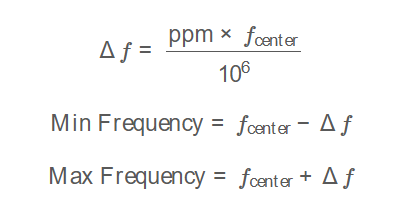1. What is PPM to Hz Calculator?
Definition: This calculator converts frequency stability in parts per million (PPM) to frequency variation in Hertz (Hz) based on the center frequency, and calculates the minimum and maximum frequency range.
Purpose: It is used in RF engineering, telecommunications, and electronics to determine the actual frequency deviation and range of oscillators and frequency sources.
2. How Does the Calculator Work?
The calculator uses the following formula:
Formula:
\[
\Delta f = \frac{\text{ppm} \times f_{\text{center}}}{10^6}
\]
\[
\text{Min Frequency} = f_{\text{center}} - \Delta f
\]
\[
\text{Max Frequency} = f_{\text{center}} + \Delta f
\]
Where:
- \( \Delta f \): Frequency Variation (Hz, kHz, MHz, GHz, THz)
- \( \text{ppm} \): Frequency Stability (parts per million)
- \( f_{\text{center}} \): Center Frequency (Hz, kHz, MHz, GHz, THz)
Unit Conversions:
- Center Frequency (\( f_{\text{center}} \)):
- 1 Hz = 1 Hertz
- 1 kHz = 1,000 Hz
- 1 MHz = 1,000,000 Hz
- 1 GHz = 1,000,000,000 Hz
- 1 THz = 1,000,000,000,000 Hz
- Frequency Variation (\( \Delta f \)), Min Frequency, Max Frequency:
- 1 Hz = 1 Hertz
- 1 kHz = 1,000 Hz
- 1 MHz = 1,000,000 Hz
- 1 GHz = 1,000,000,000 Hz
- 1 THz = 1,000,000,000,000 Hz
- Frequency Stability (ppm): Measured in parts per million (ppm), no conversion needed
Steps:
- Enter the Frequency Stability in PPM (non-negative value).
- Enter the Center Frequency and select the unit (Hz, kHz, MHz, GHz, THz).
- Convert the Center Frequency to Hertz.
- Calculate \( \Delta f = \frac{\text{ppm} \times f_{\text{center}}}{10^6} \).
- Calculate Min Frequency as \( f_{\text{center}} - \Delta f \).
- Calculate Max Frequency as \( f_{\text{center}} + \Delta f \).
- Convert all results to the selected unit (Hz, kHz, MHz, GHz, THz).
- Display the results, using scientific notation for values less than 0.001, otherwise with 4 decimal places.
3. Importance of PPM to Hz Calculation
Calculating Frequency Variation, Min Frequency, and Max Frequency from PPM is crucial for:
- RF Engineering: Determining the frequency deviation range in oscillators for RF circuits.
- Telecommunications: Ensuring signal integrity in wireless systems by understanding frequency drift limits.
- Electronics: Designing stable clocks for digital systems, such as microprocessors and communication devices.
4. Using the Calculator
Examples:
- Example 1: For \( \text{ppm} = 10 \), \( f_{\text{center}} = 10 \, \text{MHz} \), results in Hz:
- Convert to Hertz: \( f_{\text{center}} = 10,000,000 \, \text{Hz} \)
- \( \Delta f = \frac{10 \times 10,000,000}{10^6} = 100 \, \text{Hz} \)
- Min Frequency: \( 10,000,000 - 100 = 9,999,900 \, \text{Hz} \)
- Max Frequency: \( 10,000,000 + 100 = 10,000,100 \, \text{Hz} \)
- Example 2: For \( \text{ppm} = 0.5 \), \( f_{\text{center}} = 2.4 \, \text{GHz} \), results in kHz:
- Convert to Hertz: \( f_{\text{center}} = 2,400,000,000 \, \text{Hz} \)
- \( \Delta f = \frac{0.5 \times 2,400,000,000}{10^6} = 1,200 \, \text{Hz} \)
- Min Frequency: \( 2,400,000,000 - 1,200 = 2,399,998,800 \, \text{Hz} \)
- Max Frequency: \( 2,400,000,000 + 1,200 = 2,400,001,200 \, \text{Hz} \)
- Convert to kHz:
- \( \Delta f = 1,200 \div 1,000 = 1.2000 \, \text{kHz} \)
- Min Frequency: \( 2,399,998,800 \div 1,000 = 2,399,998.8000 \, \text{kHz} \)
- Max Frequency: \( 2,400,001,200 \div 1,000 = 2,400,001.2000 \, \text{kHz} \)
5. Frequently Asked Questions (FAQ)
Q: What does PPM stand for in frequency stability?
A: PPM stands for parts per million, a unit that measures the relative frequency variation compared to the center frequency.
Q: Why are Min and Max Frequency important?
A: Min and Max Frequency define the range within which the oscillator frequency may vary, critical for ensuring system reliability.
Q: How is PPM to Hz conversion used in real life?
A: It is used in designing stable frequency sources for GPS systems, cellular networks, and precision timing applications like atomic clocks.
 Home
Home
 Back
Back
